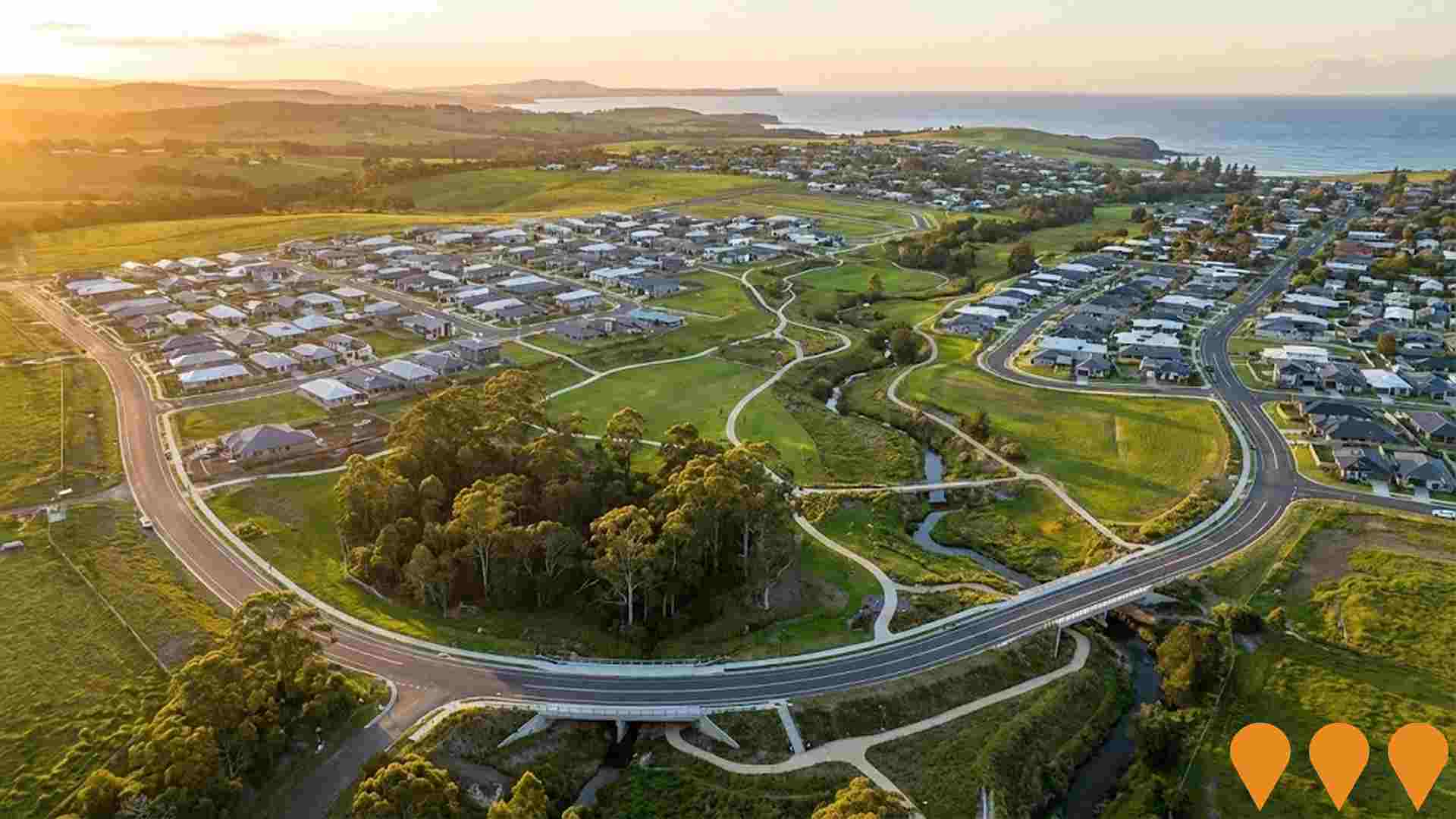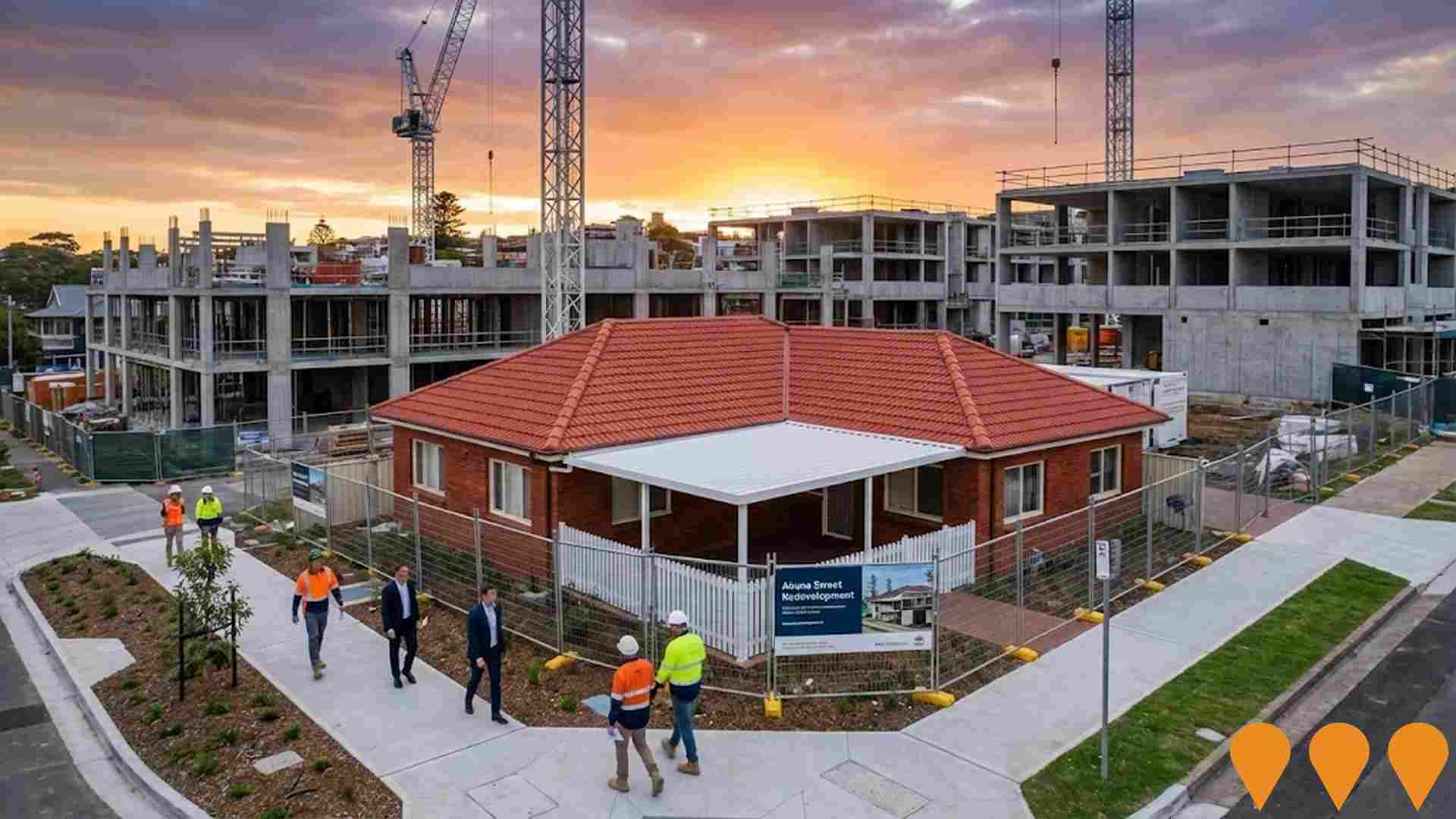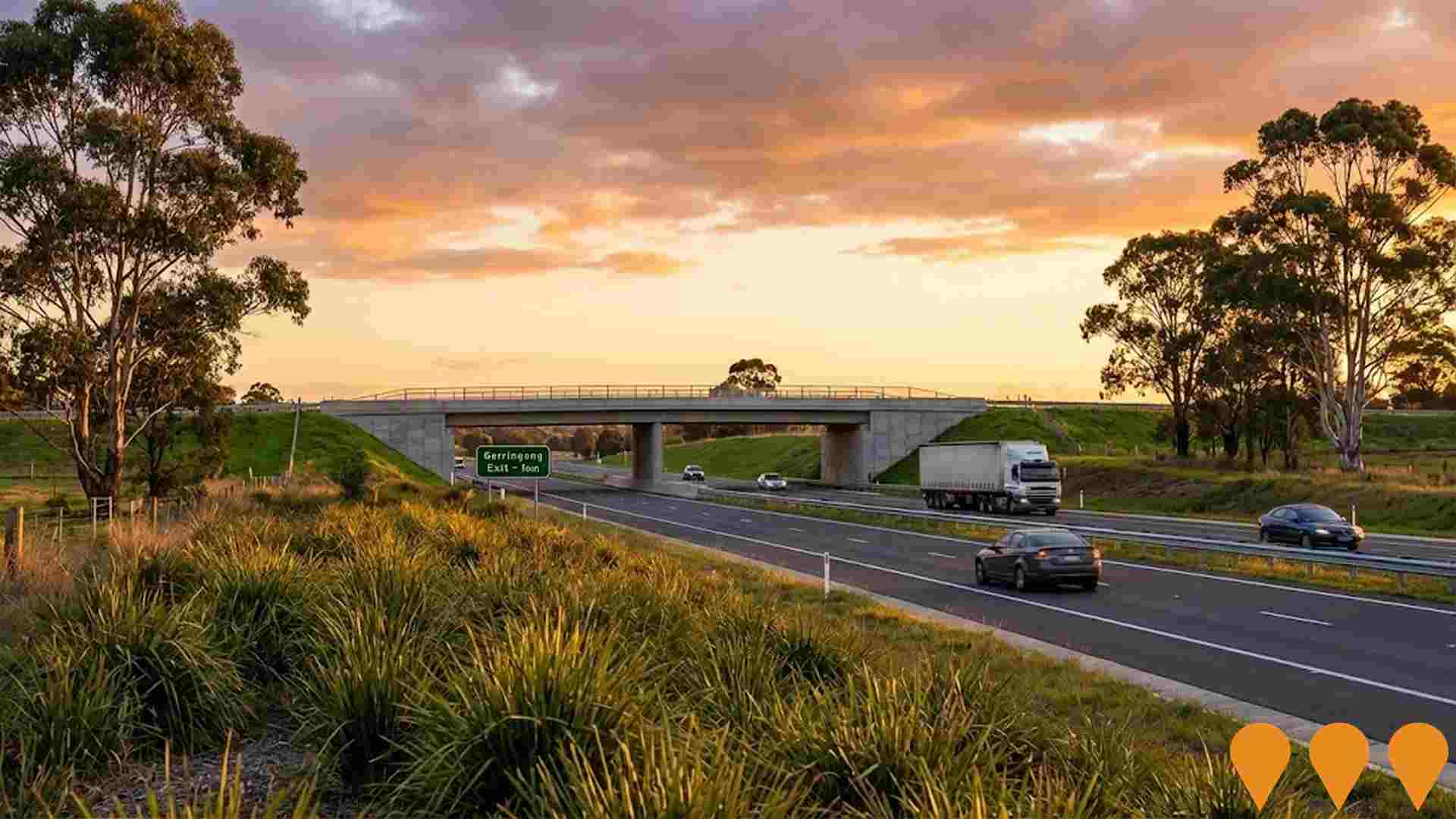Chart Color Schemes
est. as @ -- *
ABS ERP | -- people | --
2021 Census | -- people
Sales Activity
Curious about local property values? Filter the chart to assess the volume and appreciation (including resales) trends and regional comparisons, or scroll to the map below view this information at an individual property level.
Find a Recent Sale
Sales Detail
Population
Population growth drivers in Kiama Hinterland - Gerringong are strong compared to national averages based on AreaSearch's ranking of recent, and medium to long-term trends
Kiama Hinterland - Gerringong's population is around 8,121 as of Aug 2025. This reflects a decrease of 15 people since the 2021 Census, which reported a population of 8,136 people. The change is inferred from the estimated resident population of 8,088 in June 2024 and an additional 33 validated new addresses since the Census date. This level of population equates to a density ratio of 36 persons per square kilometer. Population growth was primarily driven by overseas migration during recent periods.
AreaSearch is adopting ABS/Geoscience Australia projections for each SA2 area, released in 2024 with a base year of 2022. For areas not covered, AreaSearch utilises NSW State Government's SA2 level projections, released in 2022 with a base year of 2021. Growth rates by age group are applied to all areas for years 2032 to 2041. Based on the latest population numbers, the area is expected to increase by 865 persons to 2041, with an overall increase of 10.2% over the 17 years.
Frequently Asked Questions - Population
Development
Residential development activity is lower than average in Kiama Hinterland - Gerringong according to AreaSearch's national comparison of local real estate markets
Kiama Hinterland - Gerringong granted approval for around 28 residential properties annually over the past five financial years ending June 30, totalling 144 homes. As of July 1, 2026 (FY-26), six approvals have been recorded. The population has fallen during this period, yet housing supply remains adequate relative to demand, indicating a balanced market with good buyer choice. New dwellings are developed at an average expected construction cost value of $1,062,000, reflecting a focus on the premium segment with upmarket properties.
This financial year, $7.5 million in commercial development approvals have been recorded, demonstrating the area's primarily residential nature. Compared to the rest of NSW, Kiama Hinterland - Gerringong records markedly lower building activity (60.0% below regional average per person). Recent construction comprises 83.0% detached houses and 17.0% attached dwellings, preserving the area's low density nature with an emphasis on detached housing attracting space-seeking buyers. With around 289 people per dwelling approval, Kiama Hinterland - Gerringong shows characteristics of a low density area. Population forecasts indicate Kiama Hinterland - Gerringong will gain 828 residents by the year 2041.
Existing development levels seem aligned with future requirements, maintaining stable market conditions without significant price pressures.
Frequently Asked Questions - Development
Infrastructure
Kiama Hinterland - Gerringong has strong levels of nearby infrastructure activity, ranking in the top 40% nationally
Twenty-one projects have been identified by AreaSearch as potentially impacting the area's performance. Key projects include: Sunnymede Urban Release Area, Gerringong Surf Life Saving Club Redevelopment, Princes Highway Gerringong Upgrade, and Oceania @ Gerringong. The following list details those likely to be most relevant.
Professional plan users can use the search below to filter and access additional projects.
INFRASTRUCTURE SEARCH
 Denotes AI-based impression for illustrative purposes only, not to be taken as definitive under any circumstances. Please follow links and conduct other investigations from the project's source for actual imagery. Developers and project owners wishing us to use original imagery please Contact Us and we will do so.
Denotes AI-based impression for illustrative purposes only, not to be taken as definitive under any circumstances. Please follow links and conduct other investigations from the project's source for actual imagery. Developers and project owners wishing us to use original imagery please Contact Us and we will do so.
Frequently Asked Questions - Infrastructure
Springside Hill
Springside Hill is a proposed 114-hectare masterplanned community in West Kiama featuring approximately 1200 low to medium density homes, with 25% reserved for affordable housing, essential workers, first home buyers and local residents. The development includes over 9,700 square metres of commercially zoned land for neighbourhood shops, supermarket and medical facilities, community amenities, approximately 40% open space with walking and cycling tracks along Spring Creek, and preservation of local character with sustainable design. Following Kiama Council's initial rejection in April 2024, the Southern Regional Planning Panel recommended in September 2024 that the rezoning proceed to Gateway Determination with amendments.

Sunnymede Urban Release Area
Planning Proposal PP-2025-61 to amend the Kiama Local Environmental Plan 2011 to extend the Gerringong residential zone, facilitating a proposed approximately 147 residential lots, public recreation, environmental management, environmental conservation zones, and associated infrastructure, including an access road and bridge. A Planning Agreement for approximately $7M in public benefit contributions is also being considered.

Akuna Street Mixed-Use Development
A major mixed-use redevelopment in central Kiama featuring retention of a heritage building, demolition of existing structures, and construction of 82 shop-top housing units, 24 retail premises including 2 supermarkets, food and drink premises, and 344 basement car parking spaces. The approximately $66 million development by Level 33 Property Development is currently under assessment in the Land and Environment Court (proceedings scheduled for December 2025 after mediation collapse with Kiama Council). The project will revitalise the largest redevelopment site in Kiama's town centre.

Springside Hill Master Planned Community
Proposed masterplanned community offering 1200 homes with diverse housing types, 25% guaranteed affordable housing for essential workers, first home buyers and locals. Located on 114-hectare site at 177 Long Brush Road, Jerrara. Includes community facilities, open space and Spring Creek public access.

Princes Highway Gerringong Upgrade
Upgrade of 7.5 km of the Princes Highway between Mount Pleasant and Toolijooa Road to a four-lane divided highway with median separation and two new interchanges providing access to Gerringong and Gerroa. The project improves safety, travel times and flood-resilient access to the town via Belinda Street.

Illawarra-Shoalhaven Regional Transport Plan 2041
The strategic blueprint for the region's transport network to 2041, comprising 71 initiatives to support a population of 505,000. Key projects include the $1.9 billion Princes Highway Upgrade program, Mount Ousley interchange, Picton Road upgrade, and rail improvements (More Trains, More Services). The plan targets a '30-minute city' vision, ensuring 20% of trips are made by walking, cycling, or public transport, and improving freight connections to Western Sydney.

South Kiama Urban Release Area
A 40-hectare masterplanned urban release area for approximately 380 residential lots to be delivered over four stages. Stage 1 includes 81 residential lots between 300-700 sqm, a 2000 sqm local park with basketball court and playground, riparian corridor rehabilitation, heritage conservation including Kendalls Cemetery and dry stone walls, stormwater management infrastructure, and associated roads and services. The Development Control Plan was adopted February 2025, with Stage 1 DA lodged June 2025 and currently under assessment. Estimated $14+ million for Stage 1 infrastructure alone, with subsequent stages to follow at 18-month intervals. Developer is White Constructions Developments Pty Ltd.

South Coast Line Rail Upgrade
13km of track upgraded to 25-tonne axle loading between Berry to Bomaderry and tunnels between Kiama and Berry. Enables heavier and longer rail freight services, supporting regional employment and NSW trade economy. Benefits Manildra Group operations and Port of Botany exports.

Employment
AreaSearch analysis reveals Kiama Hinterland - Gerringong significantly outperforming the majority of regions assessed nationwide
Kiama Hinterland - Gerringong has a well-educated workforce with essential services sectors well represented. The unemployment rate is 1.8% as of June 2025.
Employment growth over the past year is estimated at 0.7%. There are 4,206 residents in work while the unemployment rate is 1.9 percentage points below Rest of NSW's rate of 3.7%. Workforce participation is broadly similar to Rest of NSW's 56.4%. Key industries of employment among residents are health care & social assistance, construction, and education & training.
The area has a particular employment specialization in education & training, with an employment share of 1.3 times the regional level. Retail trade is under-represented, with only 6.8% of Kiama Hinterland - Gerringong's workforce compared to 9.8% in Rest of NSW. Employment levels increased by 0.7% during the year to June 2025, while labour force increased by 0.7%, leaving unemployment broadly flat. Jobs and Skills Australia's national employment forecasts from May 2025 suggest local growth of approximately 6.7% over five years and 13.8% over ten years.
Frequently Asked Questions - Employment
Income
Income levels align closely with national averages, indicating typical economic conditions for Australian communities according to AreaSearch analysis
AreaSearch's latest postcode level ATO data for financial year 2022 shows Kiama Hinterland - Gerringong having a high national median assessed income of $49,203 and an average income of $76,178. This contrasts with Rest of NSW's median income of $49,459 and average income of $62,998. Based on Wage Price Index growth of 12.61% since financial year 2022, current estimates for Kiama Hinterland - Gerringong would be approximately $55,407 (median) and $85,784 (average) as of September 2025. The 2021 Census data indicates that household, family, and personal incomes in Kiama Hinterland - Gerringong cluster around the 60th percentile nationally. The predominant income cohort spans 29.8% of locals (2,420 people) in the $1,500 - 2,999 category, aligning with the broader area where this cohort also represents 29.9%. After housing costs, residents retain 87.7% of income, reflecting strong purchasing power and the area's SEIFA income ranking places it in the 8th decile.
Frequently Asked Questions - Income
Housing
Kiama Hinterland - Gerringong is characterized by a predominantly suburban housing profile, with above-average rates of outright home ownership
Kiama Hinterland - Gerringong's dwellings were 86.4% houses and 13.7% other dwellings at the latest Census. This compares to Non-Metro NSW's 79.0% houses and 21.0% other dwellings. Home ownership in Kiama Hinterland - Gerringong was 51.1%, with mortgaged dwellings at 31.7% and rented ones at 17.2%. The median monthly mortgage repayment was $2,167, aligning with Non-Metro NSW's average. Median weekly rent in the area was $500, compared to Non-Metro NSW's $430. Nationally, Kiama Hinterland - Gerringong's mortgage repayments were higher at $2,167 and rents were substantially above the national figure of $375.
Frequently Asked Questions - Housing
Household Composition
Kiama Hinterland - Gerringong has a typical household mix, with a fairly typical median household size
Family households account for 76.7% of all households, including 32.7% couples with children, 36.2% couples without children, and 7.1% single parent families. Non-family households constitute the remaining 23.3%, with lone person households at 21.1% and group households comprising 2.1%. The median household size is 2.6 people, which aligns with the average for the Rest of NSW.
Frequently Asked Questions - Households
Local Schools & Education
Kiama Hinterland - Gerringong shows strong educational performance, ranking in the upper quartile nationally when assessed across multiple qualification and achievement indicators
Educational attainment in Kiama Hinterland - Gerringong shows a significant advantage with 35.2% of residents aged 15+ holding university qualifications compared to 19.9% in the SA3 area and 21.3% in the Rest of NSW. Bachelor degrees are most common at 23.3%, followed by postgraduate qualifications (8.0%) and graduate diplomas (3.9%). Vocational credentials are also prominent, with 36.9% of residents aged 15+ holding such qualifications - advanced diplomas (12.2%) and certificates (24.7%). Educational participation is high, with 26.6% of residents currently enrolled in formal education, including 8.9% in primary, 7.0% in secondary, and 4.3% in tertiary education.
Gerringong Public School and Jamberoo Public School serve a total of 523 students, with the area demonstrating above-average socio-educational conditions (ICSEA: 1063). Both schools focus on primary education, with secondary options available nearby. Local school capacity is limited at 6.4 places per 100 residents compared to the regional average of 14.3, leading many families to travel for schooling.
Frequently Asked Questions - Education
Schools Detail
Nearby Services & Amenities
Transport
Transport servicing is good compared to other areas nationally based on assessment of service frequency, route connectivity and accessibility
The analysis shows that Kiama Hinterland - Gerringong has 160 active public transport stops. These are served by a mix of train and bus services, with 22 individual routes operating in total. The combined weekly passenger trips across these routes amount to 2,578.
Residents enjoy excellent transport accessibility, with an average distance of 127 meters to the nearest stop. Service frequency stands at 368 trips per day across all routes, which translates to about 16 weekly trips per individual stop.
Frequently Asked Questions - Transport
Transport Stops Detail
Health
Health outcomes in Kiama Hinterland - Gerringong are marginally below the national average with common health conditions slightly more prevalent than average across both younger and older age cohorts
Health indicators suggest below-average outcomes in Kiama Hinterland - Gerringong, with common health conditions slightly more prevalent than average across both younger and older age cohorts. The rate of private health cover is exceptionally high at approximately 58% of the total population (4,693 people), compared to 52.7% across Rest of NSW.
The most common medical conditions in the area are arthritis and asthma, impacting 10.7 and 7.4% of residents respectively, while 66.2% declared themselves completely clear of medical ailments, compared to 65.2% across Rest of NSW. The area has 28.6% of residents aged 65 and over (2,323 people), which is higher than the 20.9% in Rest of NSW. Health outcomes among seniors are particularly strong, performing even better than the general population in health metrics.
Frequently Asked Questions - Health
Cultural Diversity
Kiama Hinterland - Gerringong is considerably less culturally diverse than average when assessed alongside AreaSearch's national rankings for language and cultural background related metrics
Kiama Hinterland-Gerringong, as per the census conducted on 9 August 2016, had a population with 87.4% born in Australia, 92.1% being citizens, and 96.2% speaking English only at home. Christianity was the predominant religion, accounting for 55.2%. Judaism, however, was slightly overrepresented at 0.2%, compared to 0.1% regionally.
In terms of ancestry, the top three groups were English (32.6%), Australian (28.1%), and Irish (11.9%). Notable divergences included Scottish (9.0% vs regional 7.2%), Maltese (0.6% vs 1.3%), and Welsh (0.6% vs 0.7%).
Frequently Asked Questions - Diversity
Age
Kiama Hinterland - Gerringong hosts an older demographic, ranking in the top quartile nationwide
Kiama Hinterland - Gerringong's median age as of the 2021 Census was 48 years, which is older than Rest of NSW's median age of 43 and significantly higher than Australia's median age of 38. The age profile shows that those aged 65 to 74 made up 15.6% of the population, a larger proportion than in Rest of NSW and well above the national average of 9.4%. Meanwhile, those aged 25 to 34 constituted only 8.3%, which is smaller compared to Rest of NSW. Post-2021 Census data shows that the 75 to 84 age group grew from 8.6% to 9.6% of the population between the censuses, while the 55 to 64 cohort declined from 15.1% to 14.2%. Demographic modeling suggests that by 2041, Kiama Hinterland - Gerringong's age profile will change significantly. The 85+ age cohort is projected to expand considerably, increasing by 223 people (an 81% rise) from 276 to 500. Conversely, population declines are projected for the 65 to 74 and 15 to 24 age cohorts.



